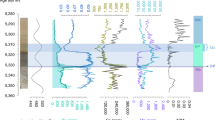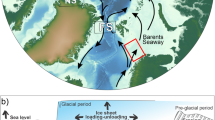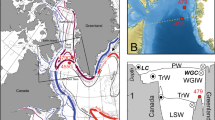Abstract
The recent discovery of the psychrospheric ostracod Agrenocythere pliocenica (Seguenza) in Zanclean marls of eastern Crete1 expands the reach of early Pliocene deep-oceanic circulation far into the eastern Mediterranean. Current models of Pliocene water-mass circulation, though allowing for the Atlantic psychrosphere to flow freely into the western basin, consider the eastern basin as being largely stagnant2,3. I propose here a new model of estuarine circulation affecting both west and east Mediterranean. This circulation was associated with increased atmospheric humidity and driven by upwelling. The model is compatible with organic-rich sedimentation in parts of the eastern Mediterranean and does not imply an excessively deep or wide connection with the Atlantic.
This is a preview of subscription content, access via your institution
Access options
Subscribe to this journal
Receive 51 print issues and online access
$199.00 per year
only $3.90 per issue
Buy this article
- Purchase on Springer Link
- Instant access to full article PDF
Prices may be subject to local taxes which are calculated during checkout
Similar content being viewed by others
References
Peters, J. M., Troelstra, S. R. & van Harten, D. J. geol. Soc. Lond. (in the press).
Benson, R. H. in The Mediterranean Sea: a Natural Sedimentation Laboratory (ed. Stanley, D. J.) 63–73 (Dowden, Stroudsburg, 1972).
Cita, M. B. & Ryan, W. B. F. Init. Rep. DSDP 13, 1405–1415 (1973).
Bruun, A. F. Mem. geol. Soc. Am. 67 (1), 641–672 (1957).
Benson, R. H. & Sylvester-Bradley, P. C. Bull. Cent. Rech. Pau 5 suppl. 63–91 (1971).
Benson, R. H. Smithson. Contr. Paleobiol. 12, 1–138 (1972).
Lacombe, H. & Tchernia, P. in The Mediterranean Sea: a Natural Sedimentation Laboratory (ed. Stanley, D. J.) 25–36 (Dowden, Stroudsburg, 1972).
Benson, R. H. Init. Rep. DSDP 42 (i) 777–787 (1978).
Colalongo, M. L. & Pasini, G. Boll. Soc. Paleont. Ital. 19, 44–126 (1980).
Carbonnel, G. & Ballesio, R. Docum. Lab. géol Lyon 85, 1–113 (1982).
Cita, M. B. & Grignani, D. in Nature and Origin of Cretaceous Carbon-Rich Facies (eds Schlanger, S. O. & Cita, M. B.) 165–196 (Academic, New York, 1982).
van Gorsel, J. T. & Troelstra, S. R. Géol. Méditerr. 7, 127–134 (1980).
Bé, A. W. H. & Tolderlund, D. S. in Micropalaeontology of Oceans (eds Funnell, B. M. & Riedel, W. R.) 105–149 (Cambridge University Press, London, 1971).
Suc, J.-P. & Zagwijn, W. D. Boreas 12, 153–166 (1983).
Suc, J.-P. Nature 307, 429–432 (1984).
Keigwin, Jr., L. D. & Thunell, R. C. Nature 282, 294–296 (1979).
Kidd, R. B., Cita, M. B. & Ryan, W. B. F. Init. Rep. DSDP 42 (1) 421–443 (1978).
Author information
Authors and Affiliations
Rights and permissions
About this article
Cite this article
van Harten, D. A model of estuarine circulation in the Pliocene Mediterranean based on new ostracod evidence. Nature 312, 359–361 (1984). https://doi.org/10.1038/312359a0
Received:
Accepted:
Issue Date:
DOI: https://doi.org/10.1038/312359a0
This article is cited by
-
Biodynamics, saline giants and late miocene catastrophism
Carbonates and Evaporites (1991)
Comments
By submitting a comment you agree to abide by our Terms and Community Guidelines. If you find something abusive or that does not comply with our terms or guidelines please flag it as inappropriate.



